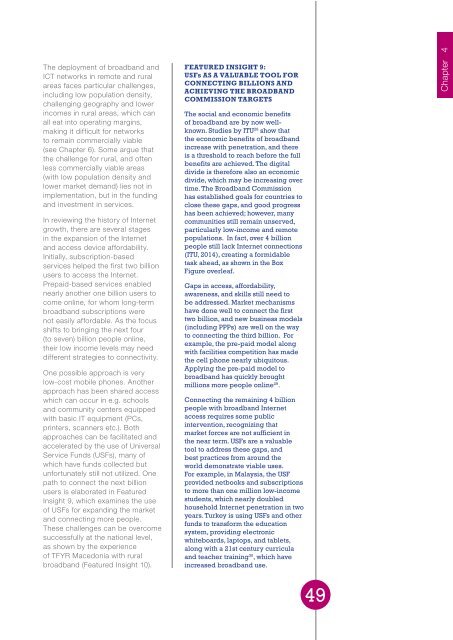DI8xz
DI8xz
DI8xz
You also want an ePaper? Increase the reach of your titles
YUMPU automatically turns print PDFs into web optimized ePapers that Google loves.
The deployment of broadband andICT networks in remote and ruralareas faces particular challenges,including low population density,challenging geography and lowerincomes in rural areas, which canall eat into operating margins,making it difficult for networksto remain commercially viable(see Chapter 6). Some argue thatthe challenge for rural, and oftenless commercially viable areas(with low population density andlower market demand) lies not inimplementation, but in the fundingand investment in services.In reviewing the history of Internetgrowth, there are several stagesin the expansion of the Internetand access device affordability.Initially, subscription-basedservices helped the first two billionusers to access the Internet.Prepaid-based services enablednearly another one billion users tocome online, for whom long-termbroadband subscriptions werenot easily affordable. As the focusshifts to bringing the next four(to seven) billion people online,their low income levels may needdifferent strategies to connectivity.One possible approach is verylow-cost mobile phones. Anotherapproach has been shared accesswhich can occur in e.g. schoolsand community centers equippedwith basic IT equipment (PCs,printers, scanners etc.). Bothapproaches can be facilitated andaccelerated by the use of UniversalService Funds (USFs), many ofwhich have funds collected butunfortunately still not utilized. Onepath to connect the next billionusers is elaborated in FeaturedInsight 9, which examines the useof USFs for expanding the marketand connecting more people.These challenges can be overcomesuccessfully at the national level,as shown by the experienceof TFYR Macedonia with ruralbroadband (Featured Insight 10).Featured Insight 9:USFs as a valuable tool forconnecting billions andachieving the BroadbandCommission targetsThe social and economic benefitsof broadband are by now wellknown.Studies by ITU 28 show thatthe economic benefits of broadbandincrease with penetration, and thereis a threshold to reach before the fullbenefits are achieved. The digitaldivide is therefore also an economicdivide, which may be increasing overtime. The Broadband Commissionhas established goals for countries toclose these gaps, and good progresshas been achieved; however, manycommunities still remain unserved,particularly low-income and remotepopulations. In fact, over 4 billionpeople still lack Internet connections(ITU, 2014), creating a formidabletask ahead, as shown in the BoxFigure overleaf.Gaps in access, affordability,awareness, and skills still need tobe addressed. Market mechanismshave done well to connect the firsttwo billion, and new business models(including PPPs) are well on the wayto connecting the third billion. Forexample, the pre-paid model alongwith facilities competition has madethe cell phone nearly ubiquitous.Applying the pre-paid model tobroadband has quickly broughtmillions more people online 29 .Connecting the remaining 4 billionpeople with broadband Internetaccess requires some publicintervention, recognizing thatmarket forces are not sufficient inthe near term. USFs are a valuabletool to address these gaps, andbest practices from around theworld demonstrate viable uses.For example, in Malaysia, the USFprovided netbooks and subscriptionsto more than one million low-incomestudents, which nearly doubledhousehold Internet penetration in twoyears. Turkey is using USFs and otherfunds to transform the educationsystem, providing electronicwhiteboards, laptops, and tablets,along with a 21st century curriculaand teacher training 30 , which haveincreased broadband use.Chapter 449


